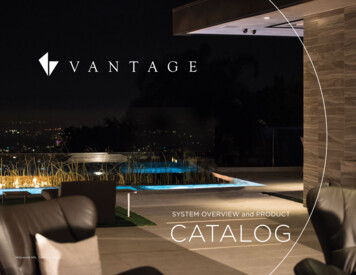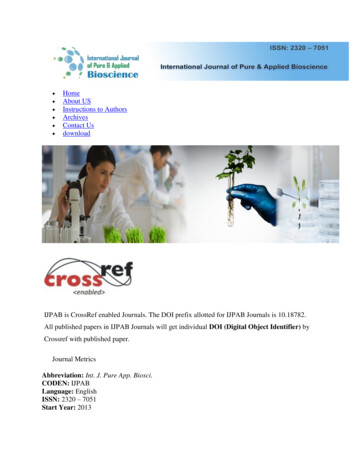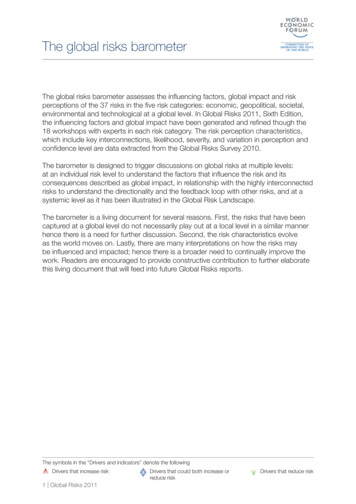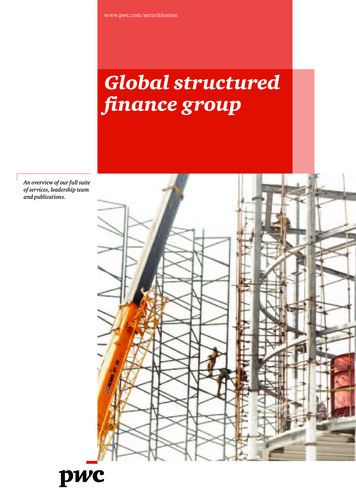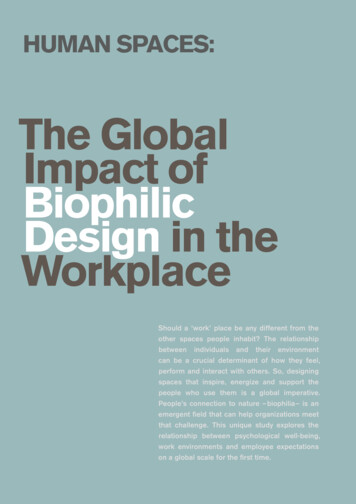
Transcription
HUMAN SPACES:The GlobalImpact ofBiophilicDesign in theWorkplaceShould a ‘work’ place be any different from theother spaces people inhabit? The relationshipbetween individuals and their environmentcan be a crucial determinant of how they feel,perform and interact with others. So, designingspaces that inspire, energize and support thepeople who use them is a global imperative.People’s connection to nature – biophilia – is anemergent field that can help organizations meetthat challenge. This unique study explores therelationship between psychological well-being,work environments and employee expectationson a global scale for the first time.
ReportGuidePreface From Bill Browning4Opening Message From Professor Sir Cary Cooper5Biophilic Design at Work6The Case for Biophilic Design11Global Urbanization9Global Research into Biophilic Design14Psychological ResponsesThe Impact of Biophilia1. Well-beingA Window On the World2. ProductivityPresenteeism in the Workplace3. Creativity17181923252930Summary33Key Messages36Appendix38Appendix One – Summary of Global Findings39Appendix Two – Summary of All Cross Country Findings41Appendix Three – Reference List44HUMAN SPACES: The Global Impact of Biophilic Design in the Workplace 3
PrefaceIt is an exciting time in the history of design, a time in which new scienceis informing our choices to improve people’s experience of the builtenvironment. Professor Sir Cary Cooper and his team at RobertsonCooper have a track record of expanding our collective understanding ofhow to create the best possible workplaces.This study undertaken by Robertson Cooper adds further strength toour understanding of how reconnecting people to nature in the builtenvironment improves well-being and productivity. While many of theresponses to biophilic design are universal human reactions, thiswork also highlights some of the subtle cultural differences in theseresponses. This study is another valuable contribution for supporting theimportant practise of biophilic design.Bill Browning, Founding Partner of Terrapin Bright Green, and one of thegreen building industry’s foremost thinkers and strategists4 HUMAN SPACES: The GlobaI Impact of Biophilic Design in the Workplace
Opening MessageFrom Professor Sir Cary CooperThis new research report is an important and practical piece, showcasingfor the first time the universal connectivity of humans with their naturaland built environments. As well as enabling organizations to make linksbetween their physical spaces and the performance of their people, thisstudy throws light on some of the cultural differences at work across theworld, and offers an answer to one of the defining factors of modern life– our ability to cope with urbanization and loss of connection with greenspaces. The backdrop to this report is both the movement of populationsfrom rural to urban environments, and the psychology of work – what dowe expect and need, and are those expectations different from country tocountry, organization to organization?The new findings revealed in this report, about how nature and biophilicdesign impact our well-being, productivity and creativity at work, aresignificant. But I hope of equal significance is that this report can inspirebusiness owners and commercial designers to take a new approach andprompt everyone to think about their own unique workplace and how bestit can support people to thrive.Professor Sir Cary Cooper, CBE, Professor of Organizational Psychologyand Health at Lancaster University, and leading expert on well-being andstress at workHUMAN SPACES: The Global Impact of Biophilic Design in the Workplace 5
HUMAN SPACES:BiophilicDesignat Work
Biophilic Designat WorkBiophilia, a concept first popularized by Edward O. Wilson in 19841, describes the innate relationship between humansand nature, and concerns the need we have to be continually connected to nature. Plenty of research confirms thishuman preference for the natural, rather than built, environment2. For example, in a 2004 study, when asked to describetheir ideal city, people more often chose non-urban characteristics, greenery in particular3, and in other studies it hasbeen shown that a pleasant and natural view can raise the price of a house considerably4.Although it has been proposed that this desire for a connection with nature is the result of an anti-urban bias combinedwith a romantic view of nature, environmental psychology research tells us that being connected to nature, is in fact, anadaptive human function that allows for, and assists with, psychological restoration5. This means that within an urbanizedenvironment, bringing in elements that allow direct nature connection (such as parks and lakes) or indirect connections(i.e., interior design using natural elements, nature-resembling colors and patterns, indoor plants and views of greenery)can help us to mentally recover and provide respite from our day-to-day activities, to maintain positive well-being.Interest in biophilia has grown substantially over the last decade, largely due to the rapid urbaniziation of the modern world,which has resulted in cities that are characterized by a predominance of manmade structures. Global figures show thisincredible shift in populations moving into urban areas over the last 60 years. Some countries, including those we haveanalyzed in this report, have seen an increase of over 40% in the number of individuals in the population residing in urbanareas since 1950. In particular, those countries that have seen the greatest economic development in recent years appearto be the nations with the greatest increase in urbanization such as Brazil (51%), Indonesia (42%), the Philippines (39%)and China (32%).Globally, it is clear that people are moving away from rural areas to towns and cities. In fact, the United Nations predicts thatby 2030, 60% of the world’s population will live in urban environments. Therefore, it is imperative that we consider how thehuman-nature connection can still be provided to those residing in towns and cities. The answer to this challenge is biophilicdesign.Often, we find that our cities and suburbs have been designed in a way that alienates us from nature and degrades theenvironment. Biophilic design is a method of designing the places in which we live and work in such a way that satisfies ourdeep and fundamental need to be connected with nature.The effects of providing this connection to nature go much further than simple employee satisfaction. An increasingresearch base has identified the positive benefits of biophilic design in supporting multiple organizational outcomes, includingwell-being, productivity and creativity.The focus of this report is on the potential benefits to be gained by satisfying humans’ biophilic needs in the workplace, aswell as the issues that surround working in environments that do not provide a connection with the natural world. Followingan EMEA (Europe, Middle East & Africa) Human Spaces report published in 2014, which analyzed original data acrosseight countries in the region and looked specifically at the impact of biophilic design in that geographical area, a secondwave of data collection has provided the base for a global research project. Collecting data from 16 countries around theworld, this research quantifies the benefits of biophilic design in the workplace. While adding to the existing evidence basefor biophilic design, we aim to provide a blueprint for nature-inspired design for high-performing organizations.HUMAN SPACES: The Global Impact of Biophilic Design in the Workplace 7
Biophilic Designat WorkResearch Methodology & Sample Profile8 Online survey of office workers across a variety of roles and sectors. 7600 employees from 16 countries across the world - United Kingdom (UK), France, Germany,Netherlands, Spain, Sweden, Demark, United Arab Emirates (UAE), United States (US), Canada, Brazil,Australia, Philippines, India, China and Indonesia. Largest proportion of respondents fell in the 25-44 age bracket (58%). Largest proportion of respondents spent 40-49 hours a week at work (40%). 39% felt 80-100% productive at work during the last three months. Well-being refers to the combination of participants’ responses to three scales: happy; inspired; andenthusiastic. These scales are taken from Robertson Cooper’s market-leading stress evaluation tool(ASSET). HUMAN SPACES: The GlobaI Impact of Biophilic Design in the Workplace
Biophilic Designat WorkGlobal UrbanizationThe table below highlights the increases in the amount of people living in urban areas during the last 60 yearsacross the 16 countries investigated in this report. Countries with the greatest increases in urbanization arehighlighted in blue6.CountryPercentage of Population Living in Urban 27Philippines276639Spain527724Sweden668519United Arab Emirates557722United Kingdom799011United States648218HUMAN SPACES: The Global Impact of Biophilic Design in the Workplace 9
Biophilic Designat WorkThe consequences of a decline in physical contact with nature are poorly understood, especially in those countriesthat are urbanizing the fastest. The purpose of the present study was to extend the scope of our research intobiophilic design by analyzing its impact on people across the globe.Background to BiophiliaBiophilic design is a response to the human need to connect with nature and works to re-establish thiscontact in the built environment. Ultimately, biophilic design is the theory, science and practise of creatingbuildings inspired by nature, with the aim to continue the individual’s connection with nature in theenvironments in which we live and work every day7.In today’s contemporary built environment, people are increasingly isolated from the beneficial experienceof natural systems and processes8. Yet it is often natural settings that people find particularly appealingand aesthetically pleasing. So, by mimicking these natural environments within the workplace, we cancreate workspaces that are imbued with positive emotional experiences. It is often the case that we don’ttake enough time to immerse ourselves in nature or appreciate the living systems that exist everywherearound us, making it vital for us to incorporate nature into our day-to-day environments.10 HUMAN SPACES: The GlobaI Impact of Biophilic Design in the Workplace
HUMAN SPACES:The Casefor BiophilicDesign
The Casefor Biophilic DesignAs it stands, the field of research into the benefits of biophilic design is accumulating evidence at a rapid pace.In an evaluative review of more than 50 empirical studies9, it has been concluded that an environment devoid ofnature may create discord, meaning that such environments can have a negative effect on health and well-being.It is noted that this discord is largely due to a lack of greenery and, in particular, a visual absence of plants. Thiscan be improved by incorporating elements of nature into these environments, by creating parks, offering views ofnature through windows, and the presence of potted plants.More recently, there has been an increasing amount of research focusing on biophilia in the context of theworkplace, looking specifically into the interaction between the design of the workplace and employee outcomes.However, despite evidence that shows people benefit from being connected with nature, it is concerning that abiophilic approach to the design of work environments is not placed higher on the global corporate agenda.Our findings emphasize the dramatic impact that even simple changes to incorporate nature in the workplace canhave on how employees feel when they come to work, and how happy, creative and productive they feel when theyare working. This should encourage organizations to consider these effects and take action to incorporate biophilicdesign practises into the workspace. While the primary focus of this report is employee well-being, productivity andcreativity, we also pay attention to measures of happiness, enthusiasm and motivation in examining how bringingnature into the workplace can elicit these positive emotions.Global Key Findings A third (33%) of office workers say that the design of an office would affect their decision to work at acompany. Only 42% report having live plants in the office and an alarming 47% report having no natural light in theiroffice. Almost a fifth (19%) of respondents report that there are no natural elements present in their office. Just under half (47%) of all respondents agree that they have felt stressed in their workplace within thelast three months. This finding emphasizes the importance of identifying and enforcing practises that canimprove well-being at work – such as biophilic design. Two thirds (67%) of respondents report feeling happy when walking into bright office environments accentedwith green, yellow or blue colors. 24% of respondents say that their workplace does not provide them with a sense of light and space. 39% of workers felt most productive at their own desk in a private office. Others said they felt mostproductive at their own desk in an open plan office (36%). 28% of respondents report that they do not have a quiet space to work in their office.12 HUMAN SPACES: The GlobaI Impact of Biophilic Design in the Workplace
The Casefor Biophilic DesignAdaptable WorkspacesGlobally, our research has shown that workers’ productivity depends upon the environment they are in. 39% ofworkers felt most productive at their own desk in a private office. The countries with the greatest preference fora private office were Germany (59%), China (52%), Canada (50%), Sweden (49%), the US (45%), Denmark(44%), France (43%) and the Netherlands (41%). 36% felt most productive at their own desk in an open planenvironment.There has been a tendency for professional workforces to move towards open plan spaces. However, what wecan see from this data is that we have individual preferences on office layout and it is important to take this intoconsideration, along with cultural preferences.Overall, 28% of respondents in the present study said that they do not have a quiet space where they can goto work. Furthermore, over 10% felt most productive in a space that suited the task, such as a quiet room for acall, or break out area.While it is only natural that preferences for type of workspace will vary, what this shows is that productivity isimpacted significantly by our surroundings.HUMAN SPACES: The Global Impact of Biophilic Design in the Workplace 13
HUMAN SPACES:GlobalResearchinto BiophilicDesign
Global Researchinto Biophilic DesignThe Human Spaces report into The Global Impact of Biophilic Design in the Workplace is the first study to take aglobal perspective of the current state of workplace design, the effect that existing design practises are having onworkers, and how making a change by bringing nature into the workplace can have a significant impact.One of the most crucial findings to emergefrom the analysis is that a third (33%) ofall respondents in the global study say thatthe design of an office would affect theirdecision to work for a company.This latest data further confirms therole that biophilia can play as part ofan employer’s brand; a growing areaof focus for businesses competing fortalent. According to Backhaus andTikoo10, employer branding “representsa firm’s efforts to promote, both withinand outside the firm, a clear view of whatmakes it different and desirable as anemployer”. While those efforts includecore elements like remuneration andpersonal development, our survey resultsdemonstrate clearly that office design isalso a part of the mix.Global office landscape47% 58%have nonatural lighthave noplantsOver ten years ago, a US study11 found that only 22% of workers quoted the physical environment as a keydesirable factor when looking for a new role. Our new research shows that this has grown to 27% in the US,compared to the global figure of 33%. This global figure is significantly impacted by data from India, Indonesiaand the Philippines, with 67%, 62% and 60% of workers, respectively, being significantly influenced by workplacedesign.When the same question was put to workers in the EMEA study, only 23% of respondents said the design of anoffice would affect their decision to work for a company. It’s possible to attribute this difference to the increasein awareness about the benefits of design factors, although it may be due to cultural differences in employeeexpectations surrounding their workplace and what it provides. Regardless of the differences, the statistics acrossall countries are significant and relevant, as they demonstrate workplace design has a definite impact on workers’perception of an organization.For organizations with ambitions to lead their market and compete for the most valuable employees, biophilicdesign can create a clear point of difference, alongside other elements of the employer brand.HUMAN SPACES: The Global Impact of Biophilic Design in the Workplace 15
Global Researchinto Biophilic DesignMany of the largest global businesses have renowned office environments that are not only part of an externalbrand, but can also help to deliver a positive employee experience. The foremost of these environments haveentered popular culture – for example, Google’s ‘Googleplex’ and the Apple campus at ‘1 Infinite Loop’. Theimpact of this type of expansive approach is reflected in a number of independent studies showing an increasein both productivity and employee retention as the result of environment transformation at work. Anthony Ravitz,leader of the “Green Team” at Google, talks about their efforts to measure productivity. For them, this isn’t just howquickly you can do a task or even how well you can do it, it’s about how you feel when you are doing it and if youhave the energy to play with your kids when you get home at the end of the day12.A number of previous case studies concerning biophilic design, such as the Genzyme example included in this report,have focused on well-being and productivity gains following redesign or new builds. No major studies, however, havebeen conducted into subsequent changes in employee attraction, and this would represent an area of interest for furtherinvestigation.What our research does show, is that natural light hits the top of the list for the most wanted element within theworkplace. However, a huge 47% of workers say that they have no natural light within their work environment. Thecountries with the greatest percentage of workers reporting that their office does not provide natural light were the UK(66%) and the US (64%). Interestingly, natural light was the number one requested element in the workplace in bothcountries, much more than any other element of design.Similarly, elements representative of the natural world, such as indoor plants and natural colors like green, blue andbrown, also made the top five, yet 58% of workers report having nogreenery, in the form of plants, within their work environment.The disparity between the preferences for natural elements withinthe workplace and what is actually present highlights the prevalenceof this issue across the globe. It would seem that a great number oforganizations are failing to provide their workers with a connection tonature, evidenced by the data that shows workers lack natural light andplants in their office space. The implications of this, in addition to thetangible benefits gained when nature is brought into the workplace,are explored in the following sections of the report. We break down theimpact of being connected to nature in the workplace into three keyareas: the impact on employee well-being; productivity; and creativity.Top five elementsmost wanted inthe office1 2 3 4 ce(19%)View ofthe sea(17%)Brightcolors(15%)The research findings allow us insight into this human connectionwith nature and the influence of well-designed workspaces. Therange of responses also allows us to make comparisons betweendifferent cultures, geographical regions and stages of economic development to propose their likely impact on employeepreferences and the degree to which individuals are affected by those preferences.16 HUMAN SPACES: The GlobaI Impact of Biophilic Design in the Workplace
Global Researchinto Biophilic DesignComment From Professor Sir Cary Cooper:Looking at a snapshot of global working environments, up to one in five people have no natural elements withintheir workspace and alarmingly nearly 50% of workers have no natural light. Yet a third of us say that workplacedesign would affect our decision to join a company. There’s a big disparity here, and one that hints at workplacedesign only recently rising to prominence as a crucial factor. For the organizations that focus on their spaces, andwork hard to deliver meaningful, inspiring workplaces, the dividends are made clear in this study. Performancejumps, as does creativity. Yet, there are no off-the-shelf templates for the utopian work environment. Incorporatebiophilia, yes, but listen to your people to make sure their preferences and ideals are reflected too.Psychological ResponsesIn addition to surveying workers about the presence of natural elements in the workspace, we also asked peopleto report on their emotional state at various points throughout the day. This enabled us to examine the immediatepsychological impact of biophilic design elements upon the individual when they first enter their workspace. Theresults (see table below) show clearly that workers entering environments that welcome workers with natural greeneryare much happier and inspired. This places emphasis on the importance of creating as natural a work environment aspossible in order to evoke these positive feelings among employees. In contrast, we also find that workers who do nothave greenery within their work environment feel more anxious and sometimes bored when they enter the workplace.GLOBAL RESEARCH FINDINGSThe table below presents the percentage of respondents (N 7600) that report feeling happy, inspired, anxiousor bored when entering workplaces that either do or do not provide internal green spaces.How do you feelwhen you enter the nal Green 5%11%Comment from Steelcase, leading office furniture manufacturer: “Well-being is made tangible throughthe workspace – this isn’t simply about work environments with better ergonomics or more comfort. Webelieve that the workplace can be a place where people actually leave healthier than when they arrive inthe morning.” Nancy Hickey (Senior Vice President and Chief Administrative Officer).HUMAN SPACES: The Global Impact of Biophilic Design in the Workplace 17
HUMAN SPACES:TheImpact ofBiophilia
The Impactof Biophilia1.Well-beingIt seems clear that urban life, with its disconnection from the natural world, stimulates a desire for contact withnature that needs to be satisfied.A key factor in maintaining positive well-being is reducing levels of stress. Research has identified that visibleconnections to nature can have a positive effect on an individual’s reported stress levels. In a review of numerousstudies looking at the effects of different landscapes on health, it was found that natural landscapes had a morepositive effect compared to urban landscapes13. In fact, in some cases, urban landscapes had a negative effect.According to our findings, this is certainly the case in France, where views of natural scenes such as greenery,wildlife and even ocean views were linked to the greatest levels of well-being among office workers and windowviews of urban scenes, such as roads and buildings were linked to a lower sense of well-being.Bill Browning: Measured ResponsesResponses to biophilic experiences have been measured in a number of ways. Much of the earlywork focused on visual preferences, indicating strong affiliations for savanna and savanna analoguelandscapes. These findings were enhanced by later research showing that viewing images of suchlandscapes trigger a stronger dopamine response (i.e., pleasure indicator) in the visual cortex of thehuman brain than scenes of nature-less manmade landscapes. Other measured responses include fasterrecovery from major surgery and shorter stays in psychological wards. Direct physical responses can bemeasured in heart rate and blood pressure, and through the levels of the stress hormone cortisol. Othermeasured responses include better cognitive performance and enhanced creativity14,15,16,17,18,19,20.Our data shows that, in Canada, the provision of green space is important inensuring that workers’ well-being is at a positive level. This is supported in recentempirical research that looked at the associations between well-being and natureconnectedness among a student population. Significant associations emerged,showing that when people were connected to nature in both their internal andexternal environment, they reported much greater levels of well-being21.Our analysis has shown that perceptions of well-being can increase by up to 15%when people work in surroundings that incorporate natural elements, providing thatconnection to nature, in contrast to those who have no contact to nature in theirworkplace. An increase of this size is certainly significant with such a large samplethat is representative of the global population. For well-being to increase thisdramatically is evidence of the power of biophilic design in the workplace and thepositive impact that this can have on employees.Workers in officeenvironmentswith natural elements,such as greeneryand sunlightreport a15%higher levelof well-beingHUMAN SPACES: The Global Impact of Biophilic Design in the Workplace 19
The Impactof BiophiliaWell-beingConsidering these findings in conjunction with workers’ reports that 47% have no natural light and 58% have nonatural greenery, organizations and designers are urged to consider design practises that ensure these elementsare present in the workplace to help maintain and increase levels of well-being.The Restorative Effects of NatureAt work, when we focus our attention on a demanding task, factors in our environment that disrupt us can leadto mental fatigue. However, workspaces that incorporate nature provide more tranquil settings that allow formore effortless attention that is less mentally draining and may indeed restore - rather than deplete - our mentalcapacity22. In academia, this is referred to as Attention Restoration Theory23, which posits that viewing andexperiencing nature engages a different part of the brain from that used in high attentional focus.It is therefore concluded that environments dominated by elements of nature are thought to be more beneficialto the individual. This point emphasizes the impact of nature on our cognitive capabilities, suggesting that byproviding nature contact within the workspace, organizations can ensure consistent levels of job performancewithin their workforce.20 HUMAN SPACES: The GlobaI Impact of Biophilic Design in the Workplace
The Impactof BiophiliaWell-beingGLOBAL RESEARCH FINDINGSNatural elements positively linked to well-being at work Nature views: Having no window view was significantly related to greater levels of reportedstress. In contrast, window views of greenery and water were linked with lower levels ofstress.Accent colors: Employee well-being is positively impacted by offices that incorporatenature-resembling colors such as green, blue and brown. It was also found that the use ofgray colors within the workspace had a significant negative impact on employees’ levels ofstress.Nature within the workspace: Across the world, those who work in offices that providenatural light, live plants and greenery along with water features, report significantly higherlevels of well-being than those who work in environments devoid of nature.Light and spacious workspaces: Those who report that their work environment provides asense of light and space report greater levels of well-being in comparison to those who donot feel that their work environment is light and spacious.United States Case Study: Genzyme CorporationIn 2004, world-leaders in biotechnology, Genzyme Corporation, designed a new corporate headquarters thatincludes features such as: natural light; a clear glass exterior; a central atrium with chandeliers at the base thatreflect sunlight; indoor gardens; water features; and windows.This building was one of the first to achieve LEED (Leadership in Energy and Environmental Design) Platinumstatus.18 months after the structure opened, its staff survey found that: 88% said having direct views and access to the natural elements indoors improved their sense of well-being. 75% said the building’s design increased their feeling of connection to co-workers.HUMAN SPACES: The Global Impact of Biophilic Design in the Workplace 21
The Impactof BiophiliaWell-beingThe impact of the work environment is already well established in Robertson Cooper’s ‘6 Essentials’ model - arobust model, validated by research with over 100,000 employees - that shows the key aspects of working life thataffect workplace well-being and employee engagement. It is designed to guide the process of making well-beingwork for an organization.6 Essentials Resources and communication Control Balanced workload Job security and change Work relationships Job conditionsPsychologicalWell-being Sense of purpose Positive emotionsOrganisationaloutcomesProductivity andperformanceAttendance (sicknessabsence)Retention (turnover)Attractiveness to recruitsCustomer/user satisfactionIndividualoutcomesProductivity andsatisfactionMorale and motivationEmployee
well-being, productivity and creativity. The focus of this report is on the potential benefits to be gained by satisfying humans’ biophilic needs in the workplace, as well as the issues that surround working in environments




